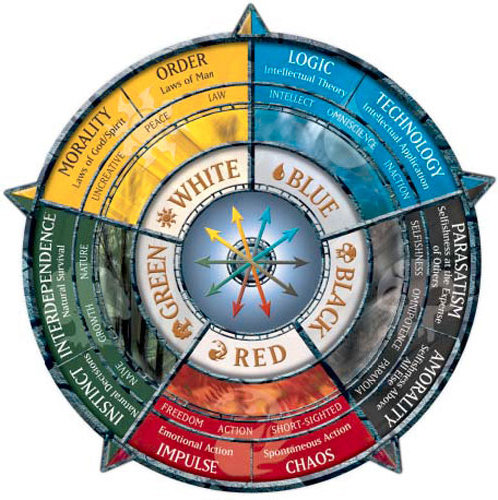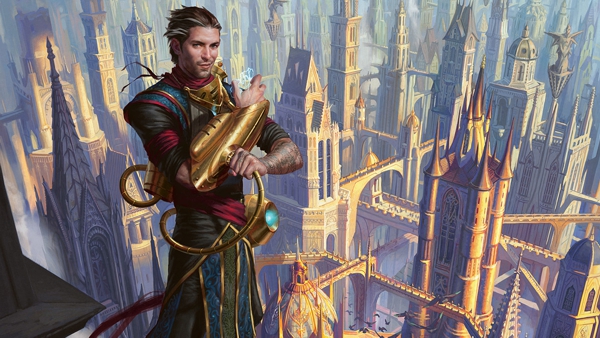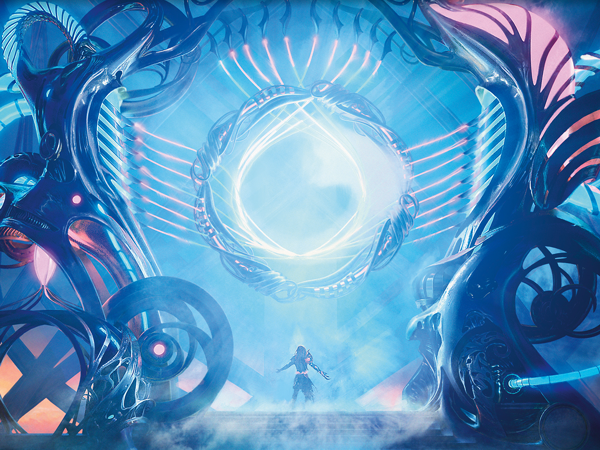The Guildmaster's Guide to Ravnica represents something that, for a long time, was considered antithetical to Wizards of the Coast's philosophy. The streams of Magic: The Gathering and Dungeons & Dragons were not to be crossed. And for almost 20 years, Magic and D&D remained officially separate. That is, until suddenly they realized that the people, and reasons, for doing this were no longer there. So why not? Magic and D&D have been sharing creative staff for years, and fans of both franchises had been asking about it for years.
Over the few weeks since the book was released, I've noticed an uptick in questions about getting started with D&D from Magic players, and getting into Magic's settings from D&D players. Ravnica: the Broken Pact is a great introduction for both the setting and mechanics. This article is meant to address some baseline questions from both camps, provide some resources, and discuss where to go from here.

Guildmaster's Guide to Ravnica Cover Art by Magali Villeneuve
New to D&D?
When I first started writing this article, I genuinely thought that I would have two sections of equal length. Once I'd already written over half of it just on incorporating Magic into D&D, however, I realized that should really be the focus. Wizards of the Coast has a whole Start Playing section and one for people New to the Game.
So what do Magic players need to know about D&D? Well, if you can calculate a complex board state in Magic, D&D shouldn't be intimidating to you. At its core, D&D is a game about creating a story with your friends and rolling dice to see if you can get away with doing incredibly stupid things. There is some reading to do at first, but don't let the dice or the reading intimidate you. There's very little you, as a new player, really need to know.
If you're looking to get into the the Guildmaster's Guide to Ravnica, you'll also need the Player's Handbook and a set of dice ranging from 4 to 20 sides (there's a great stylized set and container released alongside the Guildmaster's Guide, but you can get an ordinary set pretty cheaply). Each die is referred to by the abbreviation dX, where X is equal to the number of sides of the die. Most of the time you'll be rolling a d20, which looks a lot like a Spindown Life Counter from Magic, but isn't. A Spindown Life Counter has numbers in sequential order which is absolutely not what you want. The rules in D&D are a fantastic framework for creating a fun game and keeping the roleplaying somewhat grounded, but I've never been a part of a campaign where the Game Master (the person running the game) didn't fudge the rules to keep things interesting.
D&D is currently on the 5th Edition, so make sure anything else you want to use is geared toward what is commonly abbreviated as 5e. There are tons of great online resources for D&D, like D&D Beyond or Roll20. There are a lot of extra materials out there for D&D, but what exactly is usable outside of the Player's Handbook is going to vary from game to game.

Gatecrash Key Art by Michael Komarck
New to Magic: the Gathering?
Hello Adventurers! As you dive into Magic's lore, there are a few terms you're going to want to know. I go into some detail for these terms in Magic Story 101: Jaron and the Multiverse, but here's the cliff notes version. Fans of Magic's story, art, and flavor are known as Vorthos. Like D&D, Magic has a long storyline following adventures on different 'campaign settings', but in Magic those settings are called planes. In D&D terms, they're material planes that only planeswalkers can travel between. They're separated by the Blind Eternities, an abstract realm that only beings with a planeswalker's spark can cross and survive. Planeswalkers are the central characters of much of Magic's story, but they're incredibly rare. Depending on when you set your Magic campaign, planeswalkers may be god-like beings or mere mortals with the ability to flit between planes. Much of Magic's current story is focused on the machinations and legacies of the once god-like planeswalkers.
Each of Magic's planes has its own metaphysics that may work more like the D&D concept of Elemental Planes. You do not need to be a planeswalker to travel between these sub-planes, although the most well known ones all tend to be afterlives or the homes of gods or demons. Ravnica, for example, had a sub-plane called Agyrem, a plane home to lingering ghosts that was almost a mirror to Ravnica proper. These sub-planes could be reached through what D&D would call a planar portal. It's up to you how much of this you want to stick to, or if you'd rather adapt Magic's multiverse to be more like D&D's.

This color wheel isn't perfect, but it'll help get you started on the color pie.
Using the Color Pie
A major defining difference between Magic and D&D are the philosophies underpinning characterization. Where D&D has the alignments, you might find it more fun and flavorful to run a Magic campaign using the Color Pie. I recommend Pie Fights by Mark Rosewater if you want and in-depth look at what each color represents, but given that Ravnica's guilds are built around pairs of colors, it could be a useful tool.
Reframing D&D with the Color Pie was not within the scope of the Guildmaster's Guide, for obvious reasons. The colors don't translate well into alignments, but you may find that it allows your players more flexibility to roleplay and differentiate themselves from one another. Each of the Guilds is associated with a pair of colors, and characters from those guilds would be one or both of those colors. If you're playing a game with lots of Magic fans, references to the color pie are bound to crop up.
One potential way to use them is to replace favored terrain with the basic lands associated with each color. On a city plane like Ravnica, the traditional terrains don't apply all that well, you're unlikely to stumble across anything like grasslands, but a well-ordered Boros promenade or an Azorius plaza might be a White-aligned plains.
Using The Cards
The card search engine Scryfall is going to be your best friend as you look for inspiration. Ravnica has been the setting of Ravnica: City of Guilds, Guildpact, Dissension, Return to Ravnica, Gatecrash, Dragon's Maze, Guilds of Ravnica, and the upcoming Ravnica Allegiance (and an unnamed third set coming next spring).
There are a lot of ways to use the names, artwork, and flavor text of the cards to add authenticity to your campaign. You can use them for inspiration when designing encounters or creating characters. Having some of the real thing on hand is great for setting the mood by showing your players the art, or for generating random encounters! Create an encounter deck using cards you've hand picked, and draw a few when you need them. And because all of the magic items from the Guildmaster's Guide are based on real cards, you can even help track items by handing them the corresponding cards.

Dragon's Maze Key Art by Eric Deschamps
Where To Learn More About Ravnica
If you're looking for more information on Ravnica, check out my article Preparing for Ravnica. The dates of the last few events on there are off (go with the Guildmaster's Guide instead), but I summarize the critical pieces of Ravnica's backstory and link to a ton of resources. The most important free resources are from Return to Ravnica, which go into depth on each of the guilds and the state of the plane.
- Planeswalker's Guide to Return to Ravnica, Part 1 (Ravnica and Selesnya)
- Planeswalker's Guide to Return to Ravnica, Part 2 (Izzet and Golgari)
- Planeswalker's Guide to Return to Ravnica, Part 3 (Azorius and Rakdos)
- Planeswalker's Guide to Gatecrash, Part 1 (Dimir and Boros)
- Planeswalker's Guide to Gatecrash, Part 2 (Simic, Gruul, and Orzhov)
The Gamepedia Wiki will be a great resource for aspiring Guildmasters, and I would also recommend you check out some of the Short Stories that surround the plane. You can sort that last link by plane for ease of use. Ravnica's main story takes place over the course of a few novels, primarily named for the set they take place alongside (if you check out my Preparing for Ravnica article, I cite the stories each event is from).
The last and most important resource, however, doesn't come out until January. The Art of Magic: the Gathering - Ravnica is your holy grail sourcebook, and like the other Art Books will contain hundreds of pages of information about the setting. These books are fantastic, and their utility as sourcebooks for D&D isn't a coincidence - they're written by James Wyatt who has been a part of both the D&D and Magic creative teams.
The Timeframe of Guildmaster's Guide
The Ravnica described in the Guildmaster's Guide takes place in 10,076, between the events of Battle for Zendikar and Guilds of Ravnica. We know this because the intro adventure, Krenko's Way, takes place after the story Limits, when Gideon captures Krenko, but before Wool Over the Eyes, when the planeswalker Vraska takes over the Golgari. If you're looking to set your campaign earlier, make sure to check out Ravnica, Then and Now which breaks down the changes that happened before and after the original Ravnica block. The changes between Return to Ravnica and Guilds of Ravnica are less pronounced, as they only happened a year ago rather than 60 or 70 years ago.
The Guildmaster's Guide intentionally leaves out some of the more complicated backstories for the guilds, as the book is complex enough without them. But if you're looking to set a campaign in a different timeframe, you'll want to keep in mind that some things have changed quite a bit.

Planar Bridge by Chase Stone
To Planeswalk, or not to Planeswalk
One of the biggest questions with crossing Magic and D&D is whether or not to allow player characters to become planeswalkers. Planeswalking can be hugely problematic if you're trying to tell a story, as the characters could just up and leave for another world. I would be very careful about allowing this aspect of Magic to creep into your game. A planeswalker might make a great villain, allowing lots of last-minute escapes and mysteries as they use items and spells not of this world. The Infinite Consortium existed on Ravnica until relatively recently, and it's not a big leap to imagine someone might have resurrected it, bringing your characters into conflict with planeswalkers from all sorts of worlds.
But part of the appeal of Magic is moving between these gorgeous worlds, so if you want to allow that, there's nothing stopping you from creating your own Planar Bridge that happens to work for living creatures. Just because it's not something Magic canon currently allows shouldn't prevent your party from having fun hopping between worlds.
What's Next?
Those art books I mentioned before exist for most of Magic's major planes at this point. Alongside each release, James Wyatt has released a Plane Shift supplement that allows you to convert that plane into a D&D setting. If you like the Magic IP but want to do something a little bit different than Ravnica, exploring one of those settings would be a great place to start. I should note, however, that the only other settings with detailed maps so far are Dominaria and Ixalan, but Plane Shifts exist for the planes of Zendikar, Innistrad, Kaladesh, and Amonkhet as well.
Enjoy your Magic campaign!























